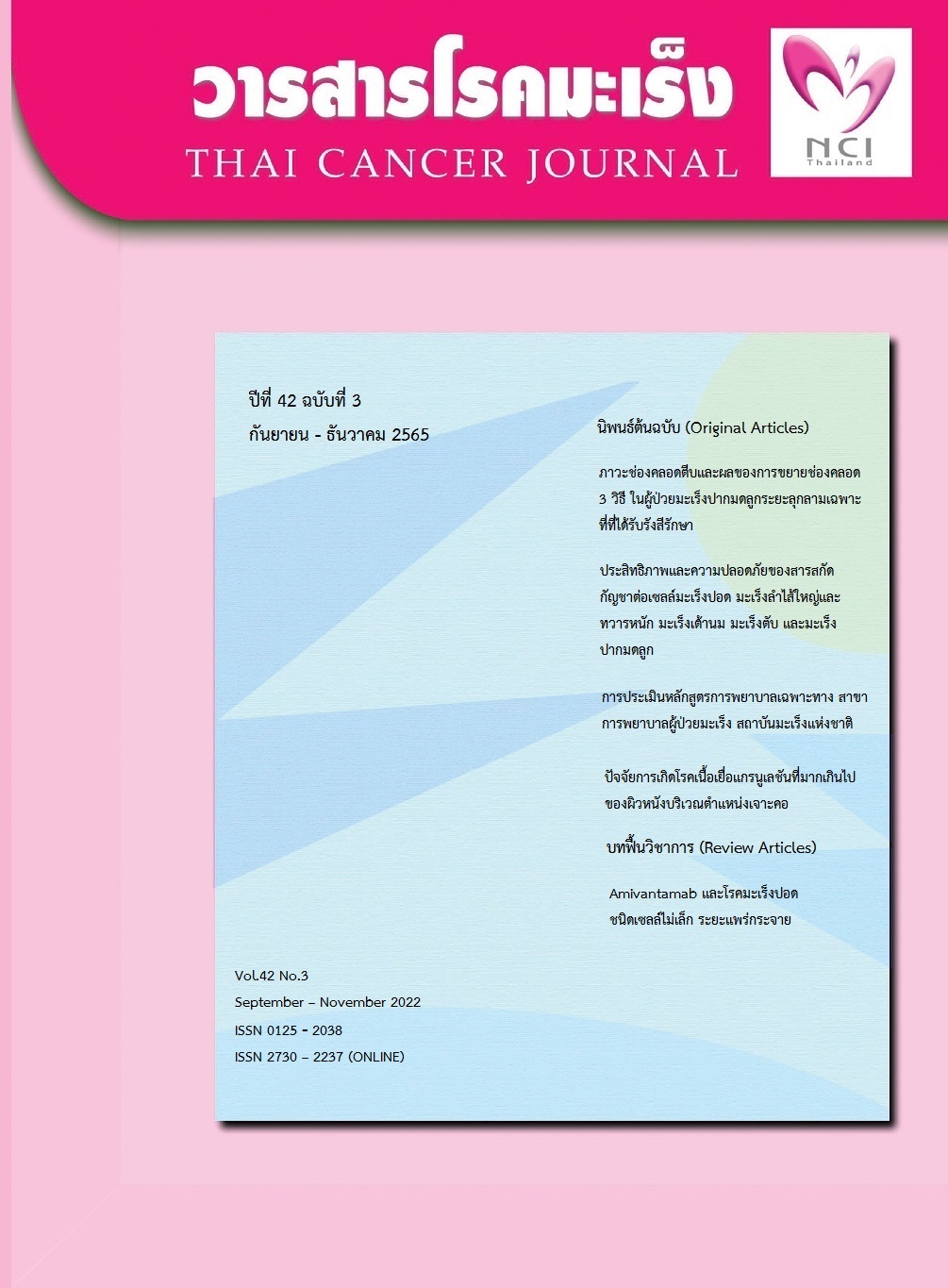Efficiency and safety of cannabis extract in cancer cell cultures
Keywords:
cannabis, cancer, cell culture, THC, CBD, Cannabis strain Issara 01, cultivated two-dimensional cell modelAbstract
Cancer is one of the most public health problems. Currently, no treatment or drug are available to completely cure the cancer. Finding a specific treatment, targeted therapy and techniques to alleviate symptoms to increase the quality of life of cancer patients,such as reducing or alleviating adverse reactions from chemotherapy and radiotherapy enhancing appetite, increasing sleep quality or reducing pain are important. Nowadays,several strains of cannabis had been used in medical practices including Issara 01 strain (Cannabis sativa L.). The cannabis extract prepared from the inflorescences of Issara 01 strain composted of Δ9-tetrahydrocannabinol (THC), Tetrahydrocannabinolic acid (THCA), Cannabigerol (CBG) and Cannabidiol (CBD) at concentration of 77.57+1.80 µg/mL, 35.84+0.71 µg/ mL, 0.75+0.05 µg/ mL, and 0.05 µg/mg, respectively. This study aimed to investigate the toxicity effect of this cannabis extract at different concentrations on cancer cells by using in vitro assay of cultivated two-dimensional cell cultures including lung cancer cells, colorectal cancer, breast cancer, liver cancer and cervical cancer. The results found that the inhibition or cytotoxicity of cannabis extract was mainly presented in breast cancer HCC 1937 and lung cancer NCI-H2170 at concentrations of 11.0+1.0 µg/mL and 16.45+3.39 µg/mL,respectively.This study concluded that although, Issara 01 strain composed of high THC and low CBD, it can inhibit cancer cells growth or be toxic to cancer cells. Therefore, this cannabis extract could be used as an optional medicine in cancer patients.
References
Imsamran W., Pattatang A., Supaattagorn P., Chiawiriyabunya I., Namthaisong K., Wongsena M.,et al.2018. Cancer in Thailand Vol.IX, 2013-2015. Cancer Registry Unit, National Cancer Institute Thailand.
ผกาทิพย์ รื่นระเริงศักดิ์. บทความเผยแพร่ความรู้สู่ประชาชน กัญชากับการรักษาโรค.เข้าถึงเมื่อ 3 กุมภาพันธ์ 2565.เข้าถึงได้จาก:https://www.pharmacy.mahidol.ac.th.
Mechouulam, R., Hanuš L.O., Pertwee R., Howlett A.C. 2014. Early phytocannabinoid chemistry to endocannabinoids and beyond. Nat. Rev. Neurol. 15: 757-64.
Velasco G., Sánchez C., Guzmán M. 2012. Towards the use of cannabinoids as antitumour agents. Nat. Rev. Cancer 12: 436-44.
Chalos F., Rocha M., Guilherme J.,Stefano S.,Silveira D.2014. Systematic review of literature on clinical and experimental trials on the antitumor effect of cannabinoids in gliomas. J Neurooncol. 116: 11-24.
ประกาศกระทรวงสาธารณสุข เรื่อง ระบุชื่อยาเสพติดให้โทษในประเภท ๕ พ.ศ. ๒๕๖๕. เข้าถึงเมื่อ 3 กุมภาพันธ์ 2565.เข้าถึงได้จาก:http://www.ratchakitcha.soc.go.th/DATA/PDF/2565/E/035/T_0008.PDF.
กรมวิชาการเกษตร กระทรวงเกษตรและสหกรณ์ เข้าถึงเมื่อ 3 กุมภาพันธ์ 2565.เข้าถึงได้จาก: https://www.doa.go.th/th/?p=26673
Mahavorasirikul W., Viyanant V., Chaijaroenkul W., Itharat A., NaBangchang K. Cytotoxic activity of Thai medicinal plants against human cholangiocarcinoma, laryngeal and hepatocarcinoma cells in vitro. BMC Complement Altern Med 2010; 10:55. doi: 10.1186/1472-6882-10-55.
Pellati F., Borgonetti V, Brighenti V., Biagi M., Benvenuti S., Corsi L. Cannabis sativa L. and Nonpsychoactive Cannabinoids: Their Chemistry and Role against Oxidative Stress, Inflammation, and Cancer. Biomed Res Int. 2018;1691428. doi: 10.1155/2018/1691428. PMID: 30627539; PMCID: PMC6304621.
Lal S., Shekher A., Puneet , Narula AS., Abrahamse H., Gupta SC. Cannabis and its constituents for cancer: History, biogenesis, chemistry and pharmacological activities. Pharmacol Res. 2021;163:105302. doi: 10.1016/j.phrs.2020.105302. Epub 2020 Nov 24. PMID: 33246167.
Milian L., Mata M., Alcacer J., Oliver M., Sancho-Tello M., Martín de Llano JJ.,et al. Cannabinoid receptor expression in non-small cell lung cancer. Effectiveness of tetrahydrocannabinol and cannabidiol inhibiting cell proliferation and epithelialmesenchymal transition in vitro. PLoS One. 2020 Feb 12;15(2):e0228909. doi: 10.1371/journal.pone.0228909. PMID: 32049991; PMCID: PMC7015420.
Kisková T., Mungenast F., Suváková M., Jäger W., Thalhammer T. Future Aspects for Cannabinoids in Breast Cancer Therapy. Int J Mol Sci. 2019 Apr 3;20(7):1673. doi: 10.3390/ijms20071673. PMID: 30987191; PMCID: PMC6479799.
Downloads
Published
Versions
- 2023-03-22 (2)
- 2023-03-22 (1)
Issue
Section
License
Copyright (c) 2022 Thailand's National Cancer Institute Foundation

This work is licensed under a Creative Commons Attribution-NonCommercial-NoDerivatives 4.0 International License.
บทความทีตีพิมพ์ในวารสารโรคมะเร็งนี้ถือว่าเป็นลิขสิทธิ์ของมูลนิธิสถาบันมะเร็งแห่งชาติ และผลงานวิชาการหรือวิจัยของคณะผู้เขียน ไม่ใช่ความคิดเห็นของบรรณาธิการหรือผู้จัดทํา







